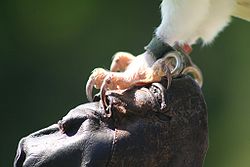.gif)
Jesses (falconry)
Encyclopedia

Hawk
The term hawk can be used in several ways:* In strict usage in Australia and Africa, to mean any of the species in the subfamily Accipitrinae, which comprises the genera Accipiter, Micronisus, Melierax, Urotriorchis and Megatriorchis. The large and widespread Accipiter genus includes goshawks,...
or falcon
Falcon
A falcon is any species of raptor in the genus Falco. The genus contains 37 species, widely distributed throughout Europe, Asia, and North America....
in falconry
Falconry
Falconry is "the taking of wild quarry in its natural state and habitat by means of a trained raptor". There are two traditional terms used to describe a person involved in falconry: a falconer flies a falcon; an austringer flies a hawk or an eagle...
. They allow a falconer to keep control of a bird while it is on the glove or in training, and allow a bird to be secured on a perch outside of its aviary. Jesses come in various types:
- Flying / Hunting jesses: short jesses without the swivel slit so as to not hamper the hawk as it flies or to snag on things as it moves from perch to perch - mainly to help control the bird while on the glove in the field. Flying jesses are often even smaller and lighter than hunting jesses, and are permanently attached to their anklets so they won't be lost; both types may have the swivel slit on them, based on the falconers preference, but most often do not.
- Mews jesses: long jesses that the hawk wears while it is in a mewsMews (falconry)In falconry, a mews is a birdhouse designed to house one or more birds of prey.In falconry there are several mews designs, the freeloft and a traditional mews. Traditional mews usually consist of partitioned spaces designed to keep tethered birds separated with perches for each bird in the...
or an aviaryAviaryAn aviary is a large enclosure for confining birds. Unlike cages, aviaries allow birds a larger living space where they can fly; hence, aviaries are also sometimes known as flight cages...
. - Traditional & Aylmeri: See below.
Jesses are generally made from strips of leather as thin as possible, for which purpose kangaroo leather has become increasingly popular over the years, as it is thin, light-weight and extremely durable with proper care. Jess size varies depending on the bird, but the width is proportional to leg-length. Traditional jesses are made from a single length of leather, and slits are placed strategically along the jess to allow it to be looped through itself and around the ankle of the bird so that it fits comfortably but securely about and just above what would be the bird's ankle. With Aylmeri jesses, as created by Major Guy Aylmer, the end of the jess is instead looped through itself repeatedly to form a "button", or knob at one end. The thin, pliable end of the jess is then threaded through an anklet worn by the bird, which is itself formed of another rectangular strip of leather, bound together at the ends by a grommet
Grommet
thumb|right|250px|Some rubber grommets.A grommet is a ring inserted into a hole through thin material, such as fabric. Grommets are generally flared or collared on each side to keep them in place, and are often made of metal, plastic, or rubber. They may be used to prevent tearing or abrasion of...
(usually of brass), prevented from slipping through the grommet by the knobbed end. Often, another slit is placed near the thin end of the jess cut about one inch long and running lengthwise, through which a special type of swivel
Swivel
A swivel is a connection that allows the connected object, such as a gun or chair, to rotate horizontally and/or vertically. A common design for a swivel is a cylindrical rod that can turn freely within a support structure. The rod is usually prevented from slipping out by a nut, washer or...
is fitted, preventing the whole arrangement from twisting or tangling about itself or the bird when a leash is threaded through the other end.
Their intent is more to prevent the risk of the bird deciding to chase something it shouldn't, and less to keep the bird from getting away, as falconry birds are routinely (and as part of the sport) set free - the bond between bird and falconer serves as a much better leash than any leather or rope ever will; however, it is not always desirable that a bird be able to take flight at its own whim, and both on the glove and on the perch, jesses help ensure this.
During hunting season (small game season for North American falconers), jesses are generally worn all season in the mews
Mews
Mews is a primarily British term formerly describing a row of stables, usually with carriage houses below and living quarters above, built around a paved yard or court, or along a street, behind large city houses, such as those of London, during the 17th and 18th centuries. The word may also...
, and are often removed for the course of the spring/summer moult, when they are generally re-oiled and serviced as necessary.

